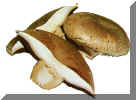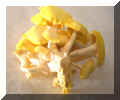|







|
|
 An
edible fungi. Early Greeks and Romans are thought to be 1st cultivators.
Ancient Egyptians considered mushrooms to be a food of the gods and
prohibited their consumption by the population; Romans believed mushrooms
gave people strength and included them in soldiers' diets. Thousands of
varieties-some cultivated, some wild - not all are edible (in fact many
are poisonous) In fact it is not legal to sell wild mushrooms in this
country in a market. An
edible fungi. Early Greeks and Romans are thought to be 1st cultivators.
Ancient Egyptians considered mushrooms to be a food of the gods and
prohibited their consumption by the population; Romans believed mushrooms
gave people strength and included them in soldiers' diets. Thousands of
varieties-some cultivated, some wild - not all are edible (in fact many
are poisonous) In fact it is not legal to sell wild mushrooms in this
country in a market.
Member of the fungus family, a very simple plant no leaves, chlorophyll,
flowers, or roots. They attach themselves to existing organic material in
order to draw nutrients The mushrooms available fresh in stores are a
cultivated variety of the wild field mushrooms, Agaricus campestris.
Canned mushrooms can be used as a substitute for
fresh
mushrooms, but fresh are preferable. Mushrooms vary a good deal in size,
and in stem length.
1 pound of medium
mushrooms should serve 4.
 Select.
Clean mushrooms with firm flesh. They should be white and the caps
should be attached to the stems. If opened, the gills should be pink;
brown gills and shriveled caps indicate loss of freshness. Select small
mushrooms for buttons, medium mushrooms for chopping or caps and large
mushrooms for broiling or stuffing. Keep refrigerated and use as
soon as possible. Do not wash before refrigerating as mushrooms continue
to absorb moisture. Select.
Clean mushrooms with firm flesh. They should be white and the caps
should be attached to the stems. If opened, the gills should be pink;
brown gills and shriveled caps indicate loss of freshness. Select small
mushrooms for buttons, medium mushrooms for chopping or caps and large
mushrooms for broiling or stuffing. Keep refrigerated and use as
soon as possible. Do not wash before refrigerating as mushrooms continue
to absorb moisture.
Serve Hot, as a vegetable
with meat, poultry or fish; as a garnish; stuffed as an appetizer or
accompaniment broiled, as a sauce; baked; as a soup; or in stews,
casseroles, etc.
Cold, raw, as an appetizer
or snack; pickled or marinated as an hors d'oeuvre or relish.
Complimentary Condiments and Flavors
Butter, bread crumbs, onions and shallots, cream, lemon juice,
cheese, tomatoes, veal, chicken, beef, salad dressing, fish.
        
|